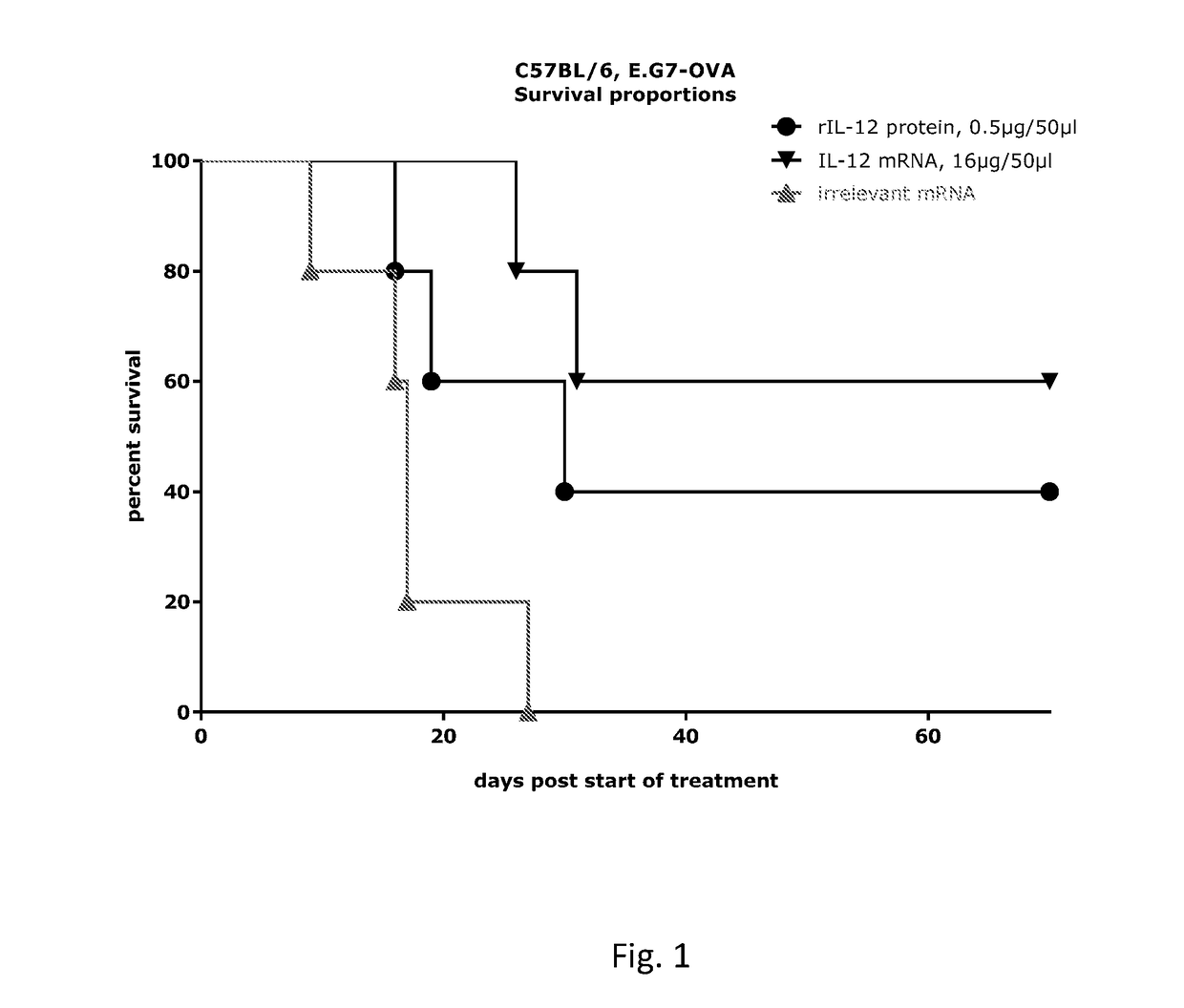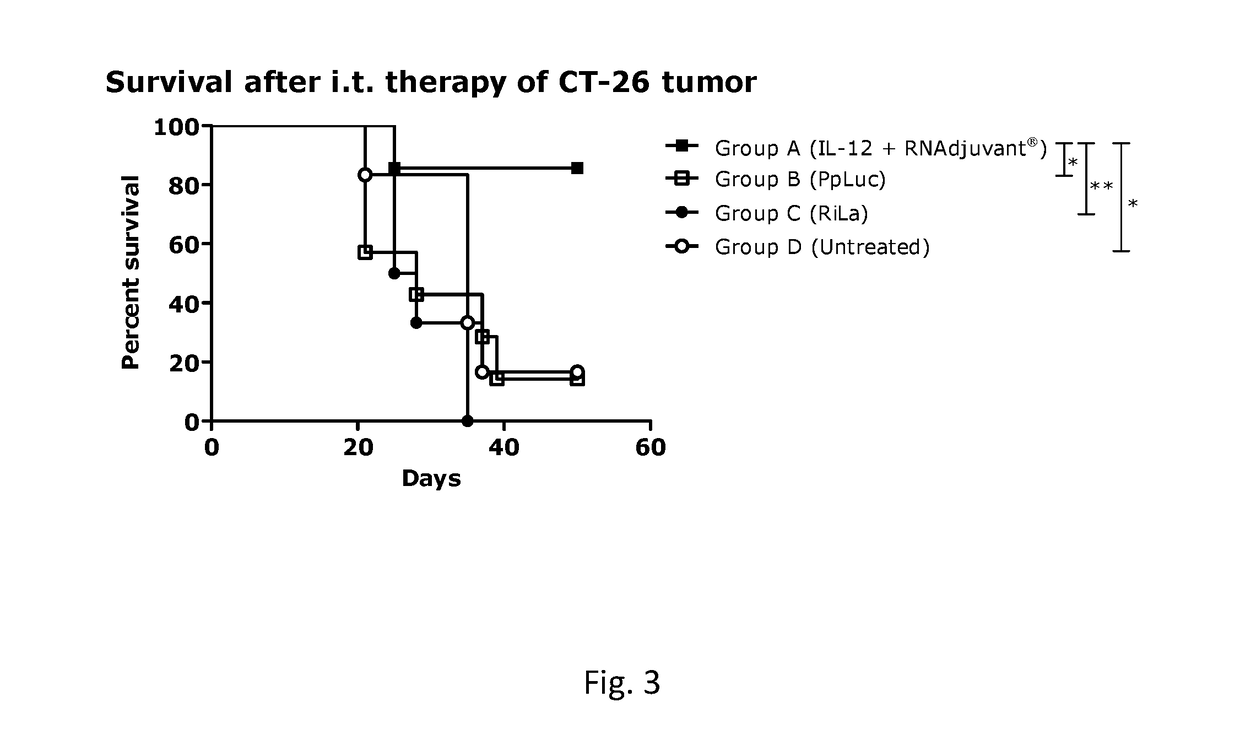RNA containing composition for treatment of tumor diseases
a composition and tumor technology, applied in the field of rna containing compositions, can solve the problems of mutated and inactivated affected genes, misinformation, and (possibly fatal) immune responses, and achieve the effect of not conferring long-lasting or protective immunity to the host, and not achieving long-lasting or protective immunity
- Summary
- Abstract
- Description
- Claims
- Application Information
AI Technical Summary
Benefits of technology
Problems solved by technology
Method used
Image
Examples
example 1
Intratumoral Application of mRNA Coding for IL-12
[0884]5 female C57BL / 6 mice per treatment group were inoculated with 106 cells E.G7-OVA cells 5 days before the first treatment. For each treatment group 5 established (about 100 mm3) subcutaneously implanted EG.7-OVA tumors were treated. Tumors were treated with 16 μg mRNA coding for MmIL-12 (MmIL-12(GC))-sc-Flag) (R1328) or 0.5 μg MmIL-12 protein on d 0, 2, 4, 21, 23 and 25 with 50 μg (1 μg / μl). As control mice were treated with an irrelevant mRNA (pPLuc) (R491).
[0885]Study day 0 is defined as the first day of treatment. Tumor growth was monitored frequently (every 2-3 days). Mice with a volume of >3 cm3 were killed.
[0886]Results of Example 1
[0887]FIG. 1 shows that the intratumoral treatment with the mRNA-encoded IL-12 (IL-12 mRNA) resulted in a significant increase in survival compared to the control group. Furthermore an increased survival could be observed compared to the intratumoral application of recombinant IL-12 protein (rIL...
example 2
Intratumoral Treatment with mRNA Encoding IL-12 in Combination with an Immunostimulating RNA (RNAdjuvant®)
[0888]The following table 18 summarizes the RNA constructs used for the example 2.
TABLE 18RNA constructs for example 2RNADescriptionFIG.SEQ ID NO.R2763Murine IL-12 encoding mRNA1SEQ ID NO. 1R2244Luciferase encoding mRNA (PpLuc)2SEQ ID NO. 2R2025Non-coding immunostimulatory RNA3SEQ ID NO. 3
[0889]Balb / c mice (n=6 or 7, see table 14) were injected subcutaneously (s.c.) with 1x106 CT26 cells (colon carcinoma cell line) per mouse (in a volume of 100 μl PBS) on the right flank on day 0 of the experiment. At day 9 after tumor challenge, mice were sorted according to the tumor size to obtain groups with a mean tumor volume of approximately 60 mm3. Intratumoral (i.t.) therapy started at day 9 and continued for additional 4 injections every 3-4 days. Mice were injected with a combination of mRNA-encoded IL-12 (25 μg of R2763)+RNAdjuvant® (25 μg of R2391) (group A). To control for local in...
example 3
Vaccination of Mice with mRNA Encoding the Influenza Nucleoprotein (NP) and Subsequent Intratumoral Treatment with NP-Encoding mRNA
[0895]The objective of this experiment was to test whether a pre-existing immune response can be harnessed against an established tumor. To this end, mice were first vaccinated with RNActive (vaccine formulation complexed with protamine) encoding the influenza nucleoprotein (NP) (R2651) which induces a high level of anti-NP CD8+ T cell responses, then challenged with CT26 tumor cells followed by intratumoral treatment with naked RNA encoding NP (R2650). 27 Balb / c mice were vaccinated intradermally (i.d.) with 40 μg of H1N1(PR8)-NP(GC) RNActive (R2651) (2×50 μl) or Ringer-Lactate buffer (RiLa) as control on day 0, day 7 and day 16 of the experiment. On day 14 all mice were challenged subcutaneously (s.c.) with 1×106 CT26 cells per mouse (in a volume of 100 μl PBS) on the right flank. On day 22, mice were assigned to the different groups as shown in Table ...
PUM
| Property | Measurement | Unit |
|---|---|---|
| composition | aaaaa | aaaaa |
| soluble | aaaaa | aaaaa |
Abstract
Description
Claims
Application Information
 Login to View More
Login to View More - R&D
- Intellectual Property
- Life Sciences
- Materials
- Tech Scout
- Unparalleled Data Quality
- Higher Quality Content
- 60% Fewer Hallucinations
Browse by: Latest US Patents, China's latest patents, Technical Efficacy Thesaurus, Application Domain, Technology Topic, Popular Technical Reports.
© 2025 PatSnap. All rights reserved.Legal|Privacy policy|Modern Slavery Act Transparency Statement|Sitemap|About US| Contact US: help@patsnap.com



